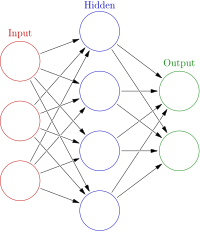
Photo from wikipedia
Over the past few decades, the prevalence of chronic illnesses in humans associated with high blood sugar has dramatically increased. Such a disease is referred to medically as diabetes mellitus.… Click to show full abstract
Over the past few decades, the prevalence of chronic illnesses in humans associated with high blood sugar has dramatically increased. Such a disease is referred to medically as diabetes mellitus. Diabetes mellitus can be categorized into three types, namely types 1, 2, and 3. When beta cells do not secrete enough insulin, type 1 diabetes develops. When beta cells create insulin, but the body is unable to use it, type 2 diabetes results. The last category is called gestational diabetes or type 3. This happens during the trimesters of pregnancy in women. Gestational diabetes, however, disappears automatically after childbirth or may continue to develop into type 2 diabetes. To improve their treatment strategies and facilitate healthcare, an automated information system to diagnose diabetes mellitus is required. In this context, this paper presents a novel system of classification of the three types of diabetes mellitus using a multi-layer neural network no-prop algorithm. The algorithm uses two major phases in the information system: the training phase and the testing phase. In each phase, the relevant attributes are identified using the attribute-selection process, and the neural network is trained individually in a multi-layer manner, starting with normal and type 1 diabetes, then normal and type 2 diabetes, and finally healthy and gestational diabetes. Classification is made more effective by the architecture of the multi-layer neural network. To provide experimental analysis and performances of diabetes diagnoses in terms of sensitivity, specificity, and accuracy, a confusion matrix is developed. The maximum specificity and sensitivity values of 0.95 and 0.97 are attained by this suggested multi-layer neural network. With an accuracy score of 97% for the categorization of diabetes mellitus, this proposed model outperforms other models, demonstrating that it is a workable and efficient approach.
Journal Title: Diagnostics
Year Published: 2023
Link to full text (if available)
Share on Social Media: Sign Up to like & get
recommendations!